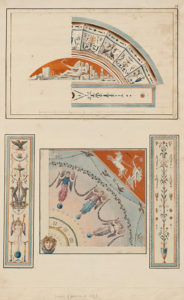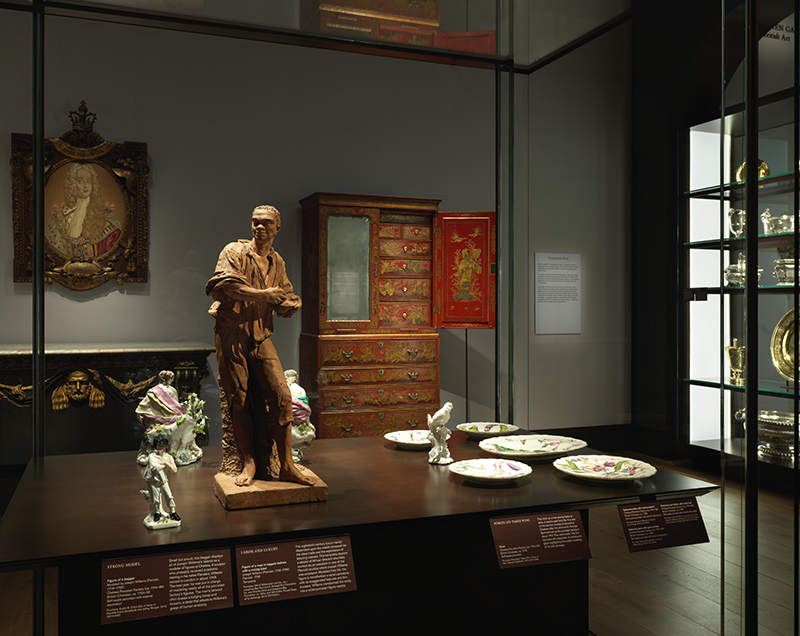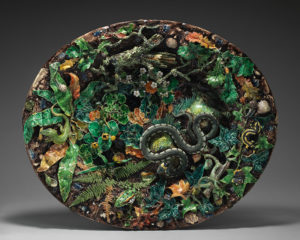Expanding Narratives of European Decorative Arts at The Met with Iris Moon
by Taryn Clary
Iris Moon is an assistant curator in the European Sculpture and Decorative Arts department at The Metropolitan Museum of Art, where she specializes in ceramics. With an undergraduate degree from Williams College and a PhD from Massachusetts Institute of Technology, she has earned fellowships at The Met, the Clark Art Institute, and the Getty Research Institute. Moon has also served as a visiting assistant professor at Pratt Institute, and, in 2016, published her dissertation, The Architecture of Percier and Fontaine and the Struggle for Sovereignty in Revolutionary France.
When Moon joined The Met in 2017, she jumped into work on the renovation of the British Galleries, a massive project that incorporated almost seven hundred works of art spanning four hundred years of history. The galleries opened on March 2, 2020, as part of the Museum’s 150th anniversary celebration, only to close two weeks later when New York City locked down in response to the pandemic. As The Met prepares to reopen to the public, Moon spoke with the Decorative Arts Trust to share insight into her past and present research, favorite aspects of the new British Galleries, and ongoing efforts to expand narratives of European decorative arts and the voices who share them.
Decorative Arts Trust: For those unfamiliar with MIT’s History, Theory and Criticism of Architecture and Art Program, how are the decorative arts incorporated into the curriculum? How did that experience prepare you for your career at The Met?
Iris Moon: The program at MIT allowed me to explore art history from a unique interdisciplinary perspective. It meshed well with my somewhat unconventional background. I was working as a contemporary art journalist in Seoul before I decided to study the architecture of the French Revolution at MIT. I started off wanting to study the visionary monuments of Étienne-Louis Boullée. But being in a small art history program within a big architecture school housed in a research university focused on sciences, math, and engineering, the decorative arts started to look really radical, fresh, and unusual! That’s how I started to consider temporary interior decoration projects and minor interventions as agents of political change during the French Revolution. When there was so little time and so little money, architects relied a lot on plaster and wallpaper to carve spaces out of preexisting structures. I became interested in the work of Charles Percier and Pierre-François-Léonard Fontaine, the two French architects who were the focus of my dissertation. (An added bonus of the program: HTC students can head up the road and take classes at Harvard for a different approach to art history!)
Working at The Met is so exciting because you get to think and ask questions with your hands, and not all the work is done in libraries and archives. Each and every piece of European ceramics and glass in the collection that I care for is a potential starting point for research. You can arrive at wonderfully rich, complex, and fascinating stories when you ask a basic set of questions in the museum: why was this object made, who made it, who was it made for, and why does it still exist?

In the style of Charles Percier and Pierre-François-Léonard Fontaine, Study for a lunette, ca. 1798-1804. Harvard Art Museums/Fogg Museum, Gift of John Goelet (1963.147.11.A), © President and Fellows of Harvard College. This project probably relates to an interior decoration project that Percier and Fontaine executed for a political assembly hall for the Brutus section at the Chapel of Saint-Joseph during the French Revolution.
DAT: Publishing a book is a big deal. What was it like to see your PhD dissertation in print?
IM: To be honest, it took several years to get over the trauma of writing the dissertation before I could think about turning it into a book! Once I decided to publish it, I realized that the text had to change because my own relationship to writing had changed so much. It was no longer a task to complete in order to earn a degree, but a way to put myself out into the world. And since my dissertation committee was no longer the sole audience, I had the freedom to choose my own ideal reader. Writing the book provided time to rediscover Percier and Fontaine as individuals who lived through some of the most tumultuous and exciting periods of French history, and to see how seemingly trivial things like wallpaper or furniture could play such an important role in architectural history. I sort of fell in love with the protagonists in the process of writing the book. If I had to choose? I’d be team Percier.
DAT: You arrived at The Met in the throes of a multi-year, multi-million-dollar project. Could you describe the experience of opening the new British Galleries only to have The Met close a few weeks later?
IM: Working on the British Galleries with my colleagues in the European Sculpture and Decorative Arts Department was a truly exhilarating and exhausting experience. Everyone worked incredibly hard to meet the opening deadline, so it was a huge disappointment to see the galleries close so soon. On the other hand, the COVID-19 crisis has allowed time to gain perspective, and to contemplate the changing relationship between the narratives of the galleries, and the social, political, and economic crises taking place outside the museum. Museums have never been neutral spaces, and the current crises we face reveal how important it is for institutions like The Met to embrace outside change. It will be interesting when the galleries finally reopen to the public, and to see how they look post-pandemic.

Joseph Willems (Flemish, 1716-1766), Figure of a man in ragged clothes with a mixing bowl, 1736. Terracotta, 29 ¼ x 11 ½ x 9 in. (74.3 x 29.2 x 22.9 cm). The Metropolitan Museum of Art. Purchase, Gift of Wildenstein and Co., Inc., by exchange; Josephine Bay Paul and C. Michael Paul Foundation Inc. and Charles Ulrick and Josephine Bay Foundation Inc. Gifts, by exchange; and Gift of Mrs. Russell Sage, by exchange, 2013. 2013.601.
DAT: Is there a gallery or installation within the new Galleries of which you are particularly proud? Or a must-see component of the Galleries once The Met reopens?
IM: One of the most challenging and thought-provoking displays in the British Galleries is the freestanding case in the eighteenth-century gallery containing our Chelsea porcelain. People don’t usually think of porcelain as political, but it’s unusual in that the display combines useful wares, such as examples of our “Hans Sloane” botanical plates, with the terracotta figure of a Black man by Joseph Willems, the manufactory’s most important modeler. We had a lot of debates about this figure, what he means, and whether he represents the racial stereotype of an enslaved African in tattered clothes, or a more individualized and sympathetic depiction of a freed Black man at work. The outsized presence of the sculptural figure may strike some as jarring, since visitors might otherwise expect to find a full service of white porcelain tableware displayed. But Willem’s talents as a modeler and his desire to bring sculptural discipline to the porcelain medium, along with the large scale of the piece, complicates the way we see this figure; he’s more than an ornament. It demands a broader range of aesthetic and political questions. Certainly, his presence is an important reminder that luxury and the consumer revolution in 18th-century Britain would not have been possible without the exploitation and expropriation of enslaved Africans and the subjugation of colonialized people. There’s a tendency for some people to look at the past through rose-colored glasses, and to wish for a world that was less complicated. But this case signals that the past was just as fraught as the present is today. The goal of a display like this is to make the act of looking at luxury and the decorative arts a complicated and perhaps even uncomfortable process, but one that is also self-reflective.

Installation view of the Chelsea porcelain case, the British Galleries, The Metropolitan Museum of Art
DAT: The museum-going public might visit the new Galleries and presume that the department’s work on British decorative arts is done for the foreseeable future. What areas of research or acquisitions do you see as important needs to fill?
IM: I certainly hope it doesn’t signal the end of the department’s interest in the British decorative arts! Personally, I would love to see more attention to pottery and earthenware, especially early British Delftware. You can never have enough Wedgwood, and I’m very happy that we received a wonderful partial gift of 18th-century creamware that includes examples by Wedgwood and Liverpool, along with some wonderful Staffordshire pipe whimseys from Leo and Frances Bretter, to celebrate the museum’s 150th anniversary. Examples of political ceramics—especially from the abolitionist and Wilkite movements—would make for a timely addition, allowing us to expand the kinds of stories we can tell with our collection. It would be great to see British protest pottery in dialogue with pieces elsewhere at The Met, such as the powerful storage jar by the American potter David Drake, which Adrienne Spinozzi in the American Wing is researching as part of her show on Edgefield ceramics. We could always use more Christopher Dresser.

Charles-Jean Avisseau (French, Saint-Pierre-des-Corps, 1795-1861), Large basin with snake, ferns, and bark, ca. 1850-1855. Glazed earthenware, 4 ¼ x 25 ⅝ x 21 ¼ in. (10.8 x 65.1 x 54 cm). The Metropolitan Museum of Art. Gift of Wallis Katz, in memory of Marshall Katz, and in celebration of the Museum’s 150th anniversary, 2020. 2020.86.15.
DAT: The Conversation Piece you developed for British Art Studies on “Luxury and Crisis: Redefining the British Decorative Arts” is a compelling and creative way to share complementary perspectives on an important topic. How did you select the broad group of participants who contributed to the project? How should museums ideally approach the need to include a breadth of voice and narrative in permanent and special exhibitions?
IM: With the Conversation Piece, the aim was to open up the topic of the British decorative arts to a broad community of thinkers, and to allow the present moment to condition different ways of thinking about luxury beyond issues of patronage, commissions, and markets. The selection of contributors came somewhat organically out of the discussions I shared with Baillie Card and Sria Chatterjee at British Art Studies and Jemma Field and Martina Droth at the Yale Center for British Art. There was really no set criteria, just a desire to think openly and capaciously about what luxury meant in a time of crisis, whether it was our own moment or of the past. There are a lot of challenges to making museums more open to a broader range of voices, but one place to start is by having honest conversations.
DAT: What research, exhibitions, and publications are you currently developing?
IM: At the moment, I am working on a display of a gift of 19th-century French and Portuguese Palissy ware from Wallis Katz, in honor of her late husband Marshall Katz and the 150th anniversary of The Met. Since most of my work is done remotely at the moment, I have a number of writing projects, including a book on luxury and the decorative arts during the French Revolution that will be published by Penn State Press, a co-edited volume with Richard Taws on Time, Media and Visuality in Post-Revolutionary France, and a special issue of British Art Studies on the decorative arts. Submissions of papers are due September 15!
Visit the British Galleries when The Metropolitan Museum of Art reopens August 29.
About The Decorative Arts Trust Bulletin
Formerly known as the "blog,” the Bulletin features new research and scholarship, travelogues, book reviews, and museum and gallery exhibitions. The Bulletin complements The Magazine of the Decorative Arts Trust, our biannual members publication.








